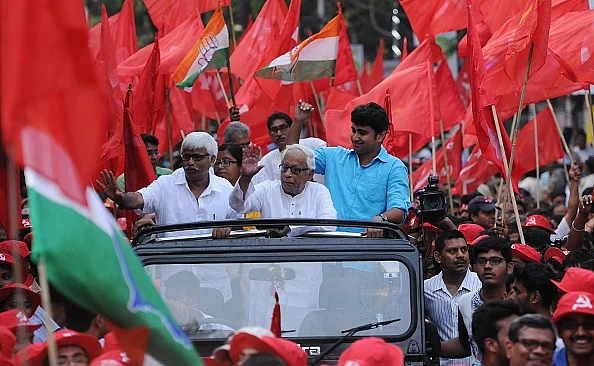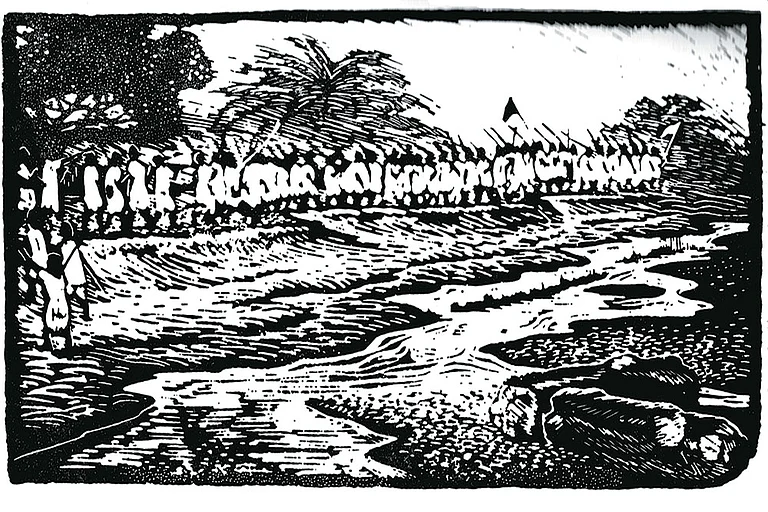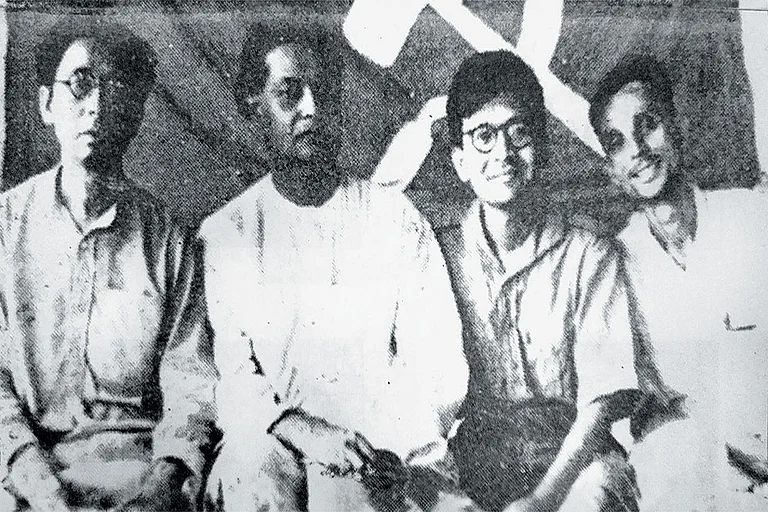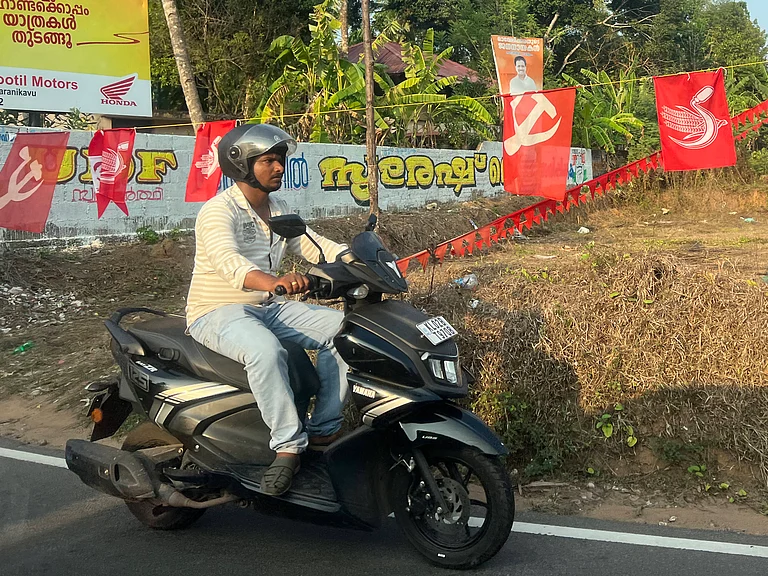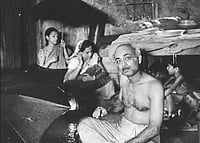Dating back to pre-independence years, Bengal had always been a brooding ground for radical national politics cradling a culture of intellectual exchange of socialist ideals. Daring revolutionary instances like the historic Chittagong Armoury Raid Case saw the youths propelled and inspired by radical left ideology take to the streets, with groups like the Jugantar Party and the Anushilan Party coming to the forefront and movements like The Tebhaga movement, a militant campaign initiated by the Communist Party of India's peasant front, Kisan Sabha, in 1946, painting a picture of the bloom of the left in the state.
The cultural landscape also morphed with the Marxist influence flowing in and led to the inclusion of educated and dynamic young people subscribing to communist ideals in its fight against colonisers, the feudal system and the glaring class differences in the country. The political contours of Bengal was thus majorly defined by these lines where people found a unshakable voice in the left, as unemployment, agrarian problems, feudal oppression and food shortage kept surging during the era and post-independence.
In 1964, following years of factional infighting, the Communist Party of India (CPI) underwent a vertical split owing to ideological differences among party members in their allegiance to the Soviet-leaning outlook and the Communist Party of China’s (CPC) ideology of mass line, in determining the national program and implementing it in India’s scenario. The Soviet-leaning faction’s line of peaceful co-existence with the western world was reflected in the right CPI faction’s strategic partnership and diplomatic relations with the Nehru government. The CPI members of the left faction who leaned towards the CPC’s line of class struggle pointed out that the class conflict would ensue in India’s semi-feudal setup. In the process of prioritising the Soviet Union’s policies and international strategy, the country's issues would be compromised and drifted away from CPI and the Congress’ flirtation mediated by the ‘revisionist’ Soviet government.
CPI and CPIM: The Internal Ideological Split
India was still recovering from the pangs of the 1962 Sino-India War and thus, the national sentiment was majorly against the CPI faction leaning towards the CPC’s ideals which saw numerous leaders getting arrested. The meetings held at West Bengal became tussle grounds between the extremists (the left faction) and the moderates within the party. The fissures within the party led to the formation of Communist Party of India (Marxist), which eventually became the dominant faction in the years to come, spearheading left politics in the country.
In the 1967 West Bengal Assembly elections, the Indian National Congress under Prafulla Chandra Sen was going against the CPI-M led United Left Front and the People’s United Left Front led by CPI and the Bangla Congress (a splinter of INC formed in 1966). The CPI(M) emerged as the second-largest party, leaving behind CPI. The alliances merged to form the United Front and established the first non-Congress government in the state with Ajoy Mukherjee of the Bangla Congress becoming the CM and CPI(M) leader Jyoti Basu becoming the Deputy CM. However, the alliance was challenged in the days to come as the Naxalbari Uprising took the state by storm.
The Naxalbari Uprising: The CPI(M)-CPIML split
In the same year, the Naxalbari uprising led by tribal and radical communist leaders gained ground in Siliguri, West Bengal, with CPI(M) leader Charu Majumder’s historic eight documents showing the way. Theorised as an essential armed struggle against the ensuing feudal oppression, the uprising saw peasants launch a violent rebellion further enraged by CPI-M’s not retaining workers in the party and swaying towards a more moderate stand away from the needs of the urgent needs of the working class . The movement saw peasant committees being established across the region within four months of the United Front coming to power in West Bengal. Land, foodgrains and arms were seized from landlord gentries, leading to a spate of violent clashes.
The government started mobilising the police forces to deal with the uprising and thus led to a movement that would alter the political landscape of the state in the years to come. Although sympathetic to the cause of the peasants and joining them in initial protests, CPI(M) in power veered away from the extremist stand of a section of party workers. The CPC’s support of the cause led to an absolute collapse of relations between CPI(M) and CPC, as arrests of radical communist leaders within the party continued. Expelled leaders like Charu Majumdar, Souren Bose and others formed the All-India Coordination Committee For Communist Revolutionaries, which later developed into the Communist Party of India (Marxist-Leninist) in 1969. The extremist party formed the nucleus of the armed rebellion in the years to come as the CPI(M) not only distanced itself from the cause of the peasants’ armed rebellion, but played an active part in repressing the movement as a part of the United Front.
The United Front Years
The following years saw a tilt in power dynamics again, as the United Front government was dismissed by the Central government leading to Bengal’s first Premier Prafulla Chandra Ghosh becoming the CM. However, in the 1969 Assembly elections, the United Front reclaimed the majority, with the CPI(M) calling the shots led by Deputy CM Jyoti Basu, and Ajoy Mukherjee of Bangla Congress reinstated as the CM. The second United Front ministry saw the CPI(M) continuing with its previous plans, but significantly developed on land reform plans, and establishing the Panchayati Raj system in the state. However, the plans could not be implemented with the alliance falling loose.
The police were asked not to intervene against striking workers, with the Home and Labour departments working under CPI(M) in the second United Front government. Arrested leaders like Kanu Sanyal and Jangal Santhal were released, and the United Front government believed that the Naxalbari uprising had fizzled out by then. However, with the release of the leaders, the CPI-ML was formed in 1969, providing the essential momentum to the movement, leading to an increase in clashes as violence surged. The CPI(M) with the Bangla Congress continued to be under pressure from Congress in Delhi, as the CPI increasingly drifted towards the Indian National Congress, pointing out CPI(M)’s dictatorial and dominative streak within the alliance. The fissures inside the party started widening leading to the ultimate collapse of the government and eventually, the alliance, giving way to the violent rule of Congress’ Siddhartha Shankar Ray in the state in 1972.
The Emergency and a tricky alliance
The CPI(M) leaders joined socialist leader Jayaprakash Narayan (JP) in their fight against the oppressive and autocratic measures that Indira Gandhi’s regime brought with it, furthered by the declaration of The Emergency in 1975. CPI(M) was in talks to enter the newly formed Janata Party, a united alliance of parties against Indira Gandhi’s faction with Jyoti Basu being a vocal critic of Gandhi and also an admirer of JP’s socialist vision. Despite previous party meetings which had clearly established the party’s lines when it came to alliances with center-right parties, CPI(M) was in talks to be part of a united front with the Janata Party. However, with the Hindutva movement playing a central cog to the alliance, CPI(M) was not formally included, as it would cause resentment among far-right members including the RSS. Nevertheless, following the Emergency, the CPI(M) allied with the extreme-right inclusive Janata Party for the 1977 General elections, which saw Janata Party taking over and forming the first non-Congress government at the Centre since independence.
The Jyoti Basu Era: 1977 to 2000
In the next few months, the Left Front alliance led by the CPI-M got an absolute majority in the West Bengal Assembly Elections, as a coalition with Janata Party had collapsed owing to seat-sharing issues. Jyoti Basu became the Chief Minister, initiating the thirty-four year Left rule in the state. Basu implemented numerous plans which looked at the issues plaguing the agrarian communities, championed the rights of the working class and focused on decentralising administration by implementation of plans like Operation Barga and formally establishing the framework for panchayat administration in the state. It led to reduction of poverty rates in the state and increased agricultural produce.
One of those instances where the Left’s ideological kernel was questioned was the 1979 Marichjhapi incident. With the Left Front coming to power, the influx of refugees exponentially increased after six years of the 1971 Bangladesh Liberation War, but the party’s refugee policy had altered by then and considered them as a burden on the state. The government considered the Hindu refugee settlement in the island of Marichjhapi an unauthorised occupation of a reserved forest land, and claimed that subsequent migration into that area could result in severe ecological disaster. It was reported that following the government’s implementation of the Section 144 of CrPC, supply of food and essentials were blocked into the island. Eyewitness accounts said that the police had opened fire killing 400-500 people, including children, following a minor disturbance.
The Left Front, under Jyoti Basu, won five assembly elections and saw Basu changing the face of the state as the CM of the state for twenty-three years. However, under Basu, a few instances highlighted the Left Front’s shifting ideological adjustments over the next couple of decades- with a significant one being the party forming an alliance under the United Front, backed by the Indian National Congress in 1996. HD Deve Gowda was chosen as the PM candidate, overlooking a towering Basu, which was considered a blunder by many.
The New Millenium: Rise And Fall
In 2000, following a crucial loss faced by the left candidate in the Panskura by-election against Mamata Banerjee’s Trinamool Congress, Jyoti Basu resigned from the CM chair at the age of 86, marking the end of a defining era of Indian politics. The baton was passed on to Buddhadeb Bhattacharya just before the 2001 Assembly elections, which saw Left Front coming to power for the sixth consecutive time, but the CPI-M failing to gain a majority of its own in the assembly, for the very first time since 1977. Bhattacharya, steered away from the orthodoxy of the other CPI-M leaders and the party’s previous ideas by focusing on rapid industrialisation and technology reforms in the state. With the clarion call of “do it now” Bhattacharya’s first tenure witnessed a strong industrial growth and establishment and major growth of IT services across the state with the formulation of Bengal’s IT Policy in 2003.
However, his second tenure marked the beginning of the end for the Left Front’s reign in Bengal. In 2006 the people of Nandigram were given a notice by Haldia Development Authority that a major portion of Nandigram would be seized and 70,000 people be evicted from their homes to establish a chemical plant. A movement against this land acquisition took place with TMC leading the charge. The Bhumi Uchched Protirodh Committee (Committee against Land Evictions) was formed to protest against the eviction. In 2007, the police allegedly opened fire killing 14 people, in which, according to multiple reports, the CPI-M cadres had a significant role to play.
Around the same time, Bhattacharya offered a significant portion of land in Singur, Hooghly to Tata Motors for its budget car, Nano, project. The decision was met with widespread protests by displaced farmers and Mamata Banerjee took charge to further the movement. The Tata Group pulled out in 2008, putting the final nail in the coffin for the Left Front government in West Bengal. The alliance built around the nucleus of recognising and safeguarding the rights of the farmers and working class, found itself in a terrible quagmire by becoming the antithesis of that. The agrarian community along with the working class found a voice in TMC’s Mamata Banerjee, which took an electoral shape in 2011, with TMC coming to power, in alliance with Congress and SUCI, and ending the Left Front’s 34-year reign in the state.
In West Bengal, CPI(M) struggled in the following assembly elections, with forged alliances with the Congress, Indian Secular Front and Left Front parties preceding the 2016 and 2021 assembly elections. While in 2016, the alliance saw waning support, 2021 established the Left Front’s political erosion with the CPI(M) failing to win a single seat in the Assembly elections for the first time since independence.







